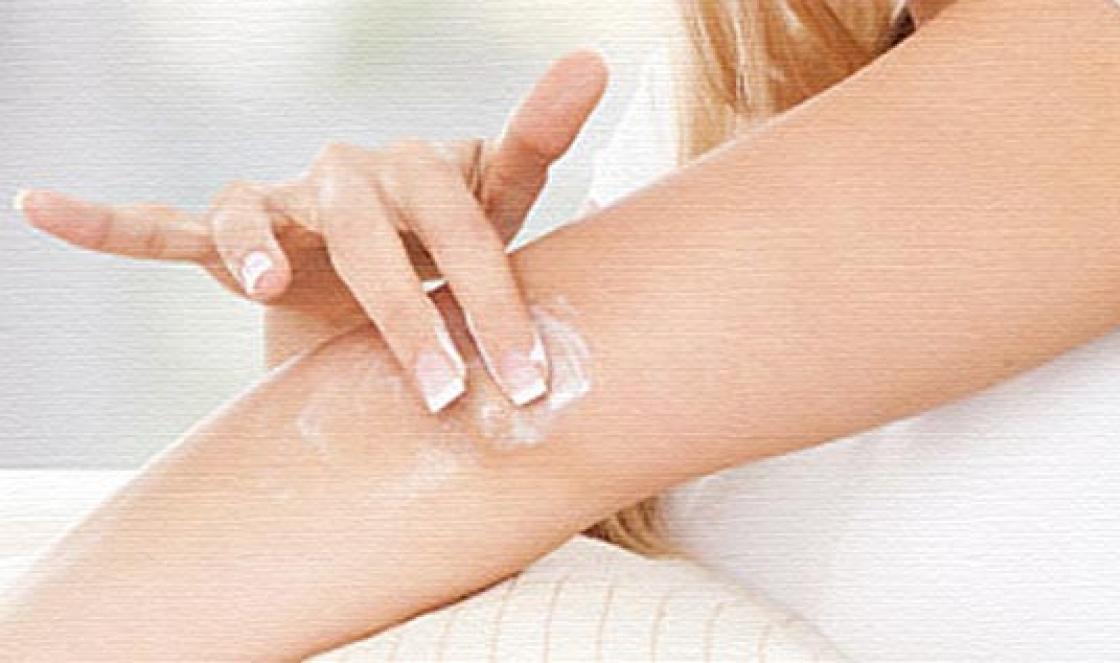Attention to the adductor muscles leads a person forward
The adductors are the muscles on the inner thigh. Their absence is a hole. Between the legs. There are six adductor muscles in total. The pectineal and lateral locking muscles are insignificant (both in size and function). Large, long, short adductor, fine-fibered - large.
The most important role in this “team” is played by the adductor magnus muscle. It begins between the pubic and ischium bones, passes behind the femur, and ends on it, on the inside of the thigh. Necessary for hip adduction and hip extension (to bring the legs together). But. If, at the moment of squatting or swinging your leg, you suddenly feel a sharp pain, it has happened. Stretching of the adductor muscle. Frequent injury among athletes.
First, calm down. Stop squatting, swinging your legs, playing football, gasping, groaning, demanding immediate compensation... Better lie down (wherever) and relax.
Apply something cold to the injury site for 15 minutes. Cool down. Then limp to the pharmacy and get something anti-inflammatory (but not warming) there. Based on diclofenac - cream, gel... Apply - 2-3 times when lazy. And - theoretically - a week is enough for normalization. If it hurts a lot, and at the site of the sprain, a rupture is suspected - limp to the doctor. What should I do?
In general, train your legs. Not to make those around you faint with envy. And not so that the size of your adductors exceeds the size of your hamstrings. But just for safety in your feet and confidence in your head. Do it.
- Squat (with or without a medicine ball).
- Do lunges (your gluteal muscles will be happy at the same time).
- Do deadlifts and leg presses.
- Move and spread your legs in a sitting position (with and without a medicine ball). It is not necessary to bend your knees.
- Mentally - just in case - say hello to the orthopedists.
- Sitting on the floor, bring your feet together and spread your knees to the sides. Grasp your feet with your hands and press your elbows onto your knees. About 30 seconds.
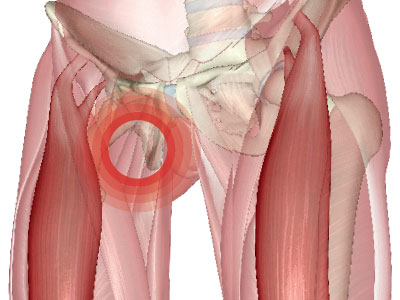 Consequence of everything
Consequence of everything And everything will be fine. There will be no discomfort or pain in the sensations. The relief of your legs will command respect not only from those around you. The splits will be normal and regular. But the shorts will have to be changed. Because the old ones will either burst or become aesthetically outdated. You can, of course, do without shorts at all. Even without any clothes. And there are no necessary reasons for this. Because the consequence is always the same. Beauty will save the world.
The material was prepared specifically for the site http://site
Related articles:
Injuries hip joint In humans, as a sports injury, it practically does not occur, but is diagnosed in early age. Hip dislocation is a condition usually associated with congenital malformation skeletal system in general or the hip area in particular. Traumatic dislocation of the hip joint is always an extremely acute condition, which can cause damage to the nerves surrounding the joint, a complete lack of active movements, and even loss of sensation in the hip area. When this injury occurs, the injured person must be taken to the hospital immediately.
A sprained adductor longus muscle is a fairly common injury in sports. The adductor muscle is located on the inner thigh. The injury most often occurs during significant hip abduction and strong simultaneous adduction, such as passing a ball in soccer. In this case, it is possible to stretch the muscle or completely tear it off, or rupture it. An acute sprain is accompanied by severe sharp pain in the inner thigh. Swelling and hematoma occur in the area of damage. Often such an injury becomes chronic: pain of varying intensity may periodically appear during training, which, however, does not prevent it from continuing.
Often a person’s injury is of a fatigue nature, when at the beginning of training in the area of the inner thigh there is moderate pain, which after warming up decreases or disappears completely, but over time becomes stronger and more diffuse. This “vicious circle” can be broken in only one way - to ensure complete restoration of the working muscles. The first sign of the onset of the development of this condition may be vague, diffuse pain in the inner thigh or groin area, which disappears after warming up. In this case, it is necessary to increase the interval between workouts to give the muscles the opportunity to fully recover.
Otherwise, a person's injury may become chronic, or a serious aggravation may occur during training, up to a complete rupture of the long adductor muscle of the thigh. Very severe injuries often require surgery. Preventing the development of such an injury involves not only full recovery, but also ensuring sufficient strength endurance and flexibility to the ligaments and muscles of the hip joint. Another fairly common injury in humans is a strained rectus femoris muscle. The rectus muscle is located on the front surface of the thigh, its function is to flex the leg at the hip joint and extend the knee joint. Often this muscle undergoes ruptures, which usually occur in the area where the muscle attaches to the patella. Strains of the rectus muscle occur more often in its upper part (above the hip joint). With this injury, pain occurs in the hip joint, but can radiate to the groin area, along the front surface of the thigh. The pain intensifies when trying to bend the hip or straighten the leg at the knee joint. Strain of the rectus femoris muscle is often in the nature of a fatigue injury, so to prevent it, sufficient recovery and the mandatory inclusion of exercises that improve stretching are necessary.
The iliopsoas muscle is located on the inner surface of the pelvis, it starts from the last thoracic vertebra and from all lumbar vertebrae and is attached to the femur. The function of the iliopsoas muscle is to flex the hip joint. An iliopsoas strain can occur as a result of repetitive hip flexion or rapid, forceful flexion with great resistance. With such an injury, pain occurs along the front and inner surface of the thigh. The pain intensifies when trying to bend the leg at the hip joint, or during exercises during which the muscle is stretched - extension at the hip joint.
Traumatic bursitis is the result of a fall or blow to the hip joint. In the hip joint area there are 13 joint capsules, which are areas of connective tissue surrounding the muscle tendons. Their function is to reduce friction during muscle contraction. With the development of traumatic bursitis, hemorrhage occurs in one or more bursae, and the greater the volume of this hemorrhage, the greater the subsequent inflammatory reaction. Often after traumatic bursitis, connective tissue develops at the site of inflammation, which leads to the formation of chronic bursitis.
Depending on which bursa or bursae were damaged, the pain may be localized in the groin area or along the front of the thigh. The development of bursitis can also be the result of insufficient recovery. For some time, microtraumas form in the muscles that do not have time to heal, which leads to swelling of the tendons, which rub against each other when moving. As a result, inflammation of the surrounding tissues, including the joint capsule, develops. The disease lasts a long time and in some cases requires surgical intervention. Prevention of this injury is, first of all, sufficient recovery, as with all other types of fatigue injuries, and adherence to the technique of the exercises performed. Pinched nerves in the groin area can occur immediately after injury, as well as as a result of the inflammatory process. The intensity, nature and location of pain may vary depending on which nerve is damaged. In any case, if pain occurs in the groin area, you should immediately consult a doctor.
What do Tom Platz and Dorian Yates have in common? Hips! Powerful, massive thighs, and not only from the front! Take a close look at their legs and you will discover well-developed muscles, which most “jocks” lack.
What do Tom Platz and Dorian Yates have in common? Hips! Powerful, massive thighs, and not only from the front! Take a close look at their legs and you will discover well-developed muscles, which most “jocks” lack. I don't mean quadriceps or hamstrings. Usually, few people suffer from a lack of volume in this pair. What I'm talking about are the adductor muscles of the thigh, and there are 6 of them in total. Two of these muscles - the pectineus and the lateral obturator - are small and not so significant. But the other four play a fundamentally important role in the development of leg muscles. The group they form is larger in volume than even the hamstring group. And the shape of the thigh at the top, where it “joins” the groin, depends on the adductor muscles. So why do few people bother to specifically work out such an important muscle group? Perhaps many of you don’t even know what “leaders” are. And if you have heard such a word, it is only in application to a simulator for adductors, which is considered to be a purely female “territory”. I must say that obstetric and gynecological movements on this thing are far from best way development of adductor muscles. But now we’ll talk about the best. But first, let's look at the anatomy. What is this - a group of leading people? In addition to the two small ones that I have already mentioned, it includes 4 large muscles: adductor magnus, adductor longus and brevis, and fine-fiber muscle. The latter originates at the pubis and is located on the surface tibia on the inside of the thigh. It performs two functions: firstly, it participates in flexion of the knee joint (as, for example, when bending the legs), and secondly, it adducts the hip. The adductor longus and brevis muscles are also attached at the top of the pubis, and then extend behind the femur. They work on hip flexion and adduction. But undoubtedly the main role in this group is played by the adductor magnus muscle - the largest among the internal, and, perhaps, external femoral muscles (with the exception, perhaps, of the broad lateral). It consists of two parts, starts between the pubic and ischium bones, passes behind the femur and ends on it on the inside of the thigh. Its functions include not only adduction of the hip, but also its extension. So what are the best exercises to develop this highly beneficial muscle group?
First let's look at squats. It is not without reason that they are called the best builder of “mass” and strength of the lower extremities, and indeed the whole body. But if we take into account only the hips, then which muscles work most actively here? Recently, research has been conducted on this using magnetic resonance technology. What kind of technology is this? The devices read the data, and right on the screen you can see which muscles are more filled with blood and which ones are less. In this way, you can judge which muscle groups are loaded more heavily and which are weaker. According to this experiment, in first place in terms of participation in squats are the three vastus muscles (internal, lateral and medial), then long and short), then the rectus femoris (1/4 quadriceps) and in last place are the biceps femoris. Moreover, the work of the last two muscles is practically zero. Participants in the experiment did 6 sets of 10 repetitions until failure, so the passivity of the rectus muscle and biceps femoris is not due to a lack of effort. Using Magnetic Resonance Technology to Study Biomechanics physical exercise started in the early 90s. The purpose of the experiments was to determine the degree of participation of muscle groups in certain movements. The experimental bodybuilders did five sets of ten repetitions per exercise. I will tell you which muscle groups (according to these experiments) behave most actively during lunges, squats, leg presses, straight leg deadlifts, and, of course, on the adductor machine.
Lunges
In my opinion no better exercise for the buttocks than lunges. But it is also extremely effective for those who lead. The main share of work here falls on the major and short adductors. They are helped by three vastus muscles. That's all - the hamstrings and teres femoris muscles don't work at all on lunges.
Hack squats
Regular hack squats (when the feet are pushed forward relative to the body) load both the vastus lateral and adductor brevis muscles, but the adductor magnus works most actively. Following them in terms of the degree of participation are the vastus internus, sartorius and fine-fiber muscles. The biceps femoris, adductor longus and rectus muscles are not involved in the movement at all. It turns out that hack squats are an exercise primarily for the adductor muscles, and not at all for the hamstrings. By placing your legs directly under your body, you engage even more thigh muscles. The main share of the load falls on the lateral and middle vastus, short and large adductors and fine-fiber muscles. They are helped by the long adductor, rectus, internal wide and sartorius. What about the hamstrings? They again remain on the sidelines.
Deadlift on straight legs
This is a great exercise for the back and inner thighs. The work here involves the adductor brevis and magnus, the biceps femoris and the semitendinosus muscle. Moreover, all these muscles are active only during the eccentric (negative) phase of the movement, when you lower the barbell back to the floor.
Romanian Deadlift (PCT)
In terms of the participation of muscle groups, this exercise is completely identical to the previous one. The difference is that with a straight-legged deadlift, the barbell moves in front of the body, and a significant load is placed on the back. This does not happen when performing the “Romanian” version. Start the exercise the same way as a stiff-legged deadlift: the first movement is to shift your butt back. Then, bending at the waist, lower the barbell down along your thighs to the middle of your shin and slowly return to the starting position. In this case, the center of gravity shifts, and the weight of the body falls mainly on the heels - that is, the body tilts back almost to the point of “tipping over” onto the back.
Leg press
In this exercise, the main work is performed by three broad muscles and two adductors - long and short. When the feet rest on top part platform, the main load falls on the adductor longus muscle. When you focus on the lower part of the platform, the load moves to the hamstrings. All other muscles behave like well-bred children: quietly and meekly.
Squats
In terms of muscle recruitment, foot placement during squats is not that important. In both positions, the main work is performed by the three vastus muscles of the thigh, assisted by the three adductors and the rectus muscle. Front squats are a slightly different story, albeit with a similar outcome. The movement involves approximately the same muscle groups as during regular squats. Smith machine squats again use three broad muscles, but here the work also includes the sartorius, adductor brevis, semimembrane and semitendinosus muscles. But the large and long adductors remain aside. So Smith machine squats are designed to target the hamstrings rather than the adductors.
Adductor muscle trainer
This design perfectly works the adductor magnus muscle, and to a lesser extent the fine-fiber muscle. The rest are enjoying a well-deserved rest.
So what exercise most effectively develops the adductor group? As you can see, there is a wide choice. My advice: try all the exercises we talked about. Another good (even great) exercise for this purpose is the Sumo row, with a very wide stance, thanks to which both the adductors and extensors of the hips are loaded. Combinations of these exercises will help you “make” thighs that you could only dream of. I don't mean Cindy Crawford's legs, although she has damn good ones. I'm talking about well-rounded, symmetrical hips that are equally impressive from the front, back and sides. It is possible that you will grow up to be Tom Platz. No, I'm not joking at all! Believe me: nature has given each of us powerful potential for the development of leg muscles! All that remains is to take yours by applying competent, scientifically based training!
Medial thigh muscle group (hip adductors):
M. pectineus, pectineus muscle, starting from the superior ramus and crest of the pubis and from the lig. pubicum superius, goes down and somewhat to the side and is attached to the linea pectinea of the femur. With its lateral edge, the pectineus muscle comes into contact with m. iliopsoas. Both of these muscles, converging with each other, form triangular shape a fossa, fossa iliopectinea, in which the femoral vessels are located immediately upon their exit from the pelvis. (Inn. L2-L3. Nn. obturatorius et femoralis.)
M. adductor longus, the long adductor muscle, originates on the anterior surface of the superior ramus of the pubis and is attached to the medial lip linea aspera femoris in its middle third. (Inn. L2-L3. N. obturatorius.)
M. adductor brevis, the short adductor muscle, lies under the previous muscles. It starts from the anterior surface of the pubic bone and is attached to the medial lip linea aspera femoris in the upper part. (Inn. L2-L4. N. obturatorius.)
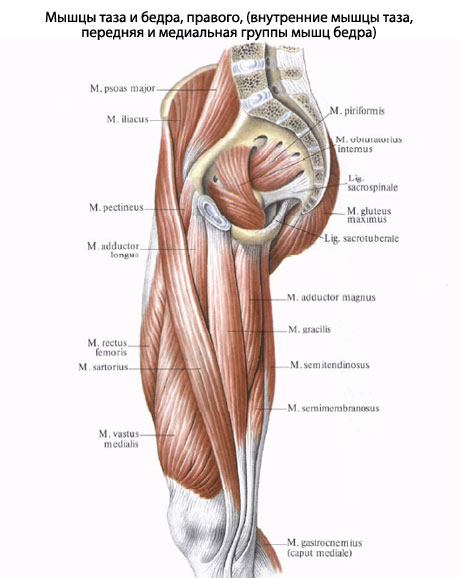
M. adductor magnus, adductor magnus, the most powerful of all adductor muscles. It lies furthest posteriorly and is covered anteriorly in its proximal part mm. adductores brevis et longus. Starting from the branches of the pubic and ischial bones and from the tuber ischiadicum, m. The adductor magnus is directed to the lateral side and is attached to the medial lip of the linea aspera femoris along its entire length to the medial condyle of the femur. The upper fibers of the muscle run from the pubis to the insertion site almost transversely and are described separately under the name of the adductor minor muscle, m. adductor minimus. (Inn. L3-L5. N. obturatorius and partly P. ischiadicus.)
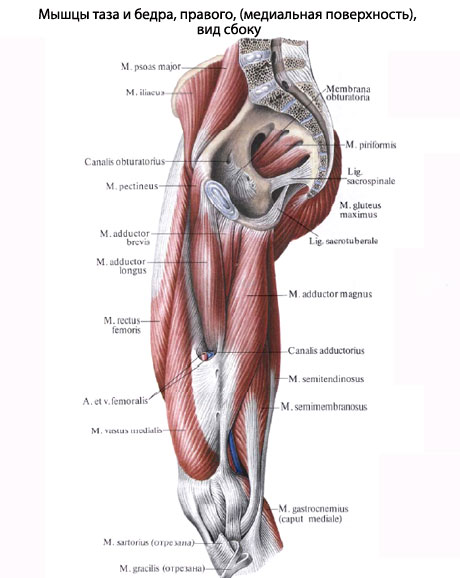
M. gracilis, gracilis muscle, a long and narrow muscle band running superficially along the medial edge of the general mass of the adductor muscles. Its origin is located on the lower branch of the pubic bone near the pubic symphysis. Attached to the fascia of the leg at tuberositas tibiae. (Inn. L3-L4. N. obturatorius.) Function. All adductor muscles, according to their name, produce adduction of the thigh, turning it slightly outward. Those of them that cross the transverse axis of the hip joint in front (mm. pectineus, adductor longus et brevis) can also produce flexion in this joint, and m. The adductor magnus, located posterior to this axis, on the contrary, produces extension in it. M. gracilis, as it spreads over two joints, in addition to adducting the hip, also flexes the tibia at the knee joint and rotates it medially.
Which doctors should I contact for examination of the thigh muscles:
Traumatologist
What diseases are associated with the thigh muscles:
What tests and diagnostics need to be done for the thigh muscles:
Examination by a traumatologist
Is something bothering you? Do you want to know more detailed information about the Thigh Muscles or do you need an examination? You can make an appointment with a doctor– clinic Eurolab always at your service! The best doctors will examine you, advise you, provide necessary help and make a diagnosis. You can also call a doctor at home. Clinic Eurolab open for you around the clock.
How to contact the clinic:
Phone number of our clinic in Kyiv: (+38 044) 206-20-00 (multi-channel). The clinic secretary will select a convenient day and time for you to visit the doctor. Our coordinates and directions are indicated. Look in more detail about all the clinic’s services on it.
If you have previously performed any research, Be sure to take their results to a doctor for consultation. If the studies have not been performed, we will do everything necessary in our clinic or with our colleagues in other clinics.
It is necessary to take a very careful approach to your overall health. There are many diseases that at first do not manifest themselves in our body, but in the end it turns out that, unfortunately, it is too late to treat them. To do this, you just need to do it several times a year. be examined by a doctor, in order not only to prevent a terrible disease, but also to maintain a healthy spirit in the body and the organism as a whole.
If you want to ask a doctor a question, use the online consultation section, perhaps you will find answers to your questions there and read self care tips. If you are interested in reviews about clinics and doctors, try to find the information you need on. Also register on the medical portal Eurolab to stay up to date latest news and updates to information about the Thigh Muscles on the website, which will be automatically sent to you by email.
Other anatomical terms starting with the letter "M":
| Milk ducts |
| Scrotum |
| Bladder |
| Uterus |
| Cerebellum |
| Muscles of the trunk |
| Muscles of the upper limb |
| Muscles of the lower limb |
| Muscles of the head and neck |
| Ureters |
| Urethra (male) |
| Urinary duct |
| Urine |
| Muscles |
| Forearm muscles |
| Fibula |
| Melanin |
| Fallopian tube |
| Labia minora |
| Mammary glands (breasts) |
| Little finger |
| Perineal muscles |
| Myocardium |
| Intercostal veins |
| Bridge |
| Medial surface of the hemisphere |
| Peroneal nerve |
| Muscles of the eyeball |
| Interphalangeal joints |
| Back muscles |
| Levator scapulae muscle |
| Erector spinae muscle |
| Muscles of the medial tract of the back |
| Muscles that lift the ribs |
| Chest muscles |
| Abdominal muscles |
| Neck muscles |
| Head muscles |
| Facial muscles |
| Muscles of the cranial vault |
| Eye muscles |
| Oral muscles |
| Nasal muscles |
| Shoulder muscles |
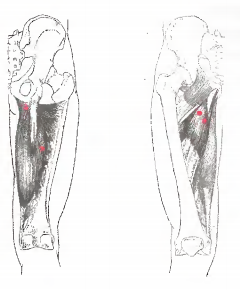
Adductor longus muscle
Adductor brevis muscle
Adductor major muscle
Adductor muscles and tension points
Left: adductor magnus muscle
Right: adductor longus and brevis muscles
ADDUTORING MUSCLES, or adductors, are located on the inner side of the thigh and form the main layer of muscle tissue here. They pull their legs towards the midline of the body. People often confuse the terms “adductors” and “abductors.” The difference is that adductors pull the legs up, while abductors lift them away from the midline of the body.
If stress points are present in the adductors, pain occurs in the groin and inner thighs. Additionally, this pain can make it difficult to abduct, lateralize, or rotate your hips, indicating problems with the abductor muscles. Other symptoms include pain deep in the pelvis, in the bladder or vagina, and sometimes during sexual intercourse. Unfortunately, people often look for the source of these pains outside the muscles and therefore suffer for years.
Adductor longus and brevis muscles connect the pubic and femur bones. Stress points in these muscles lead to pain in the groin and upper inner thigh. Stress points at the top of the longus muscle can make it difficult for the knee joint to move. The pain usually increases with increased activity, as well as while standing or carrying a load.
Adductor major muscle located behind the longus and brevis muscles, it runs from the groin along the entire length of the thigh and connects the ischium to the back of the two thigh bones. Stress points in this muscle cause pain in the groin and inner thigh, which can radiate down to the knee.
In addition, all adductor muscles can cause severe pain in the pubic bone, vagina, rectum and bladder. These pains are so severe that they are confused with pelvic inflammation and other diseases of the reproductive organs and bladder.
In order to find adductors and work with them, you must first become familiar with what they are. femoral triangle. Sit on the floor and stretch your legs in front of you.
Bend one of your legs at the knee and place its sole against knee joint straight leg (from the inside). If this position is not very comfortable for you, you can do the same on the couch. In this case, the bent leg will be located completely on the sofa, and the other leg will be positioned as if you were sitting.
Feel the inner thigh of your bent leg. To begin, find the articulation between your hip and pelvis. This is where the inguinal ligament is located. It runs from the outer end of the pubic bone to the femur. Inguinal ligament forms the basis of the femoral triangle, the outer part of which is formed sartorius muscle, and the internal one is the adductor longus muscle. The lower part of the triangle is formed from the inside by tissues iliacus muscle, and with the outer - fabrics pectineus muscle. In this triangle you can feel the pulse of the femoral artery. Here you can also find lymph nodes, which become enlarged when the immune system fights infection.
It is impossible to feel the adductor brevis muscle, since it lies under the long muscle.
The adductor longus muscle is the most noticeable muscle, and therefore it is easy to find and feel with your fingers from the groin to the middle of the inner thigh. Once you find tight bands and points of tension, press the muscle there to relax it. However, if your fingers cannot perform this task effectively enough, use a tennis ball or some other small, hard ball. In general, on the modern market there are many different devices that can help us. The basis of success is regular training. You should do the rex wop until your muscles are completely relaxed. You may have to do this exercise several times a day for some time before you are successful.
To find stress points in the adductor large muscle, you need to sit in the pose described above, not so that the foot is at a distance of 25 cm from the straight leg. Having felt the points of tension and tight bands of muscles, try to relax them. The easiest way to relax is to sit on the floor and stretch your legs forward. Place the hard ball under the soft spot and let gravity do its work. Relax your leg and transfer its weight onto the ball. Repeat this several times until you are completely relaxed.
It is very important to stretch afterwards.
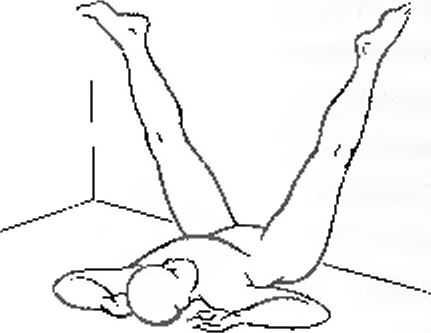 |
Adductor Stretching |
Stretch: Lie on the floor with your back so that your buttocks are facing the wall (as shown in the picture). Your legs should be raised up the wall. Slowly move them apart and maintain this position for 30-60 seconds. Gravity will help you stretch the muscles on your inner thigh. Since the adductor magnus muscle is located and works in close proximity to the biceps femoris muscle, it is important to stretch it as well for complete relaxation. To do this, use hamstring stretches.



